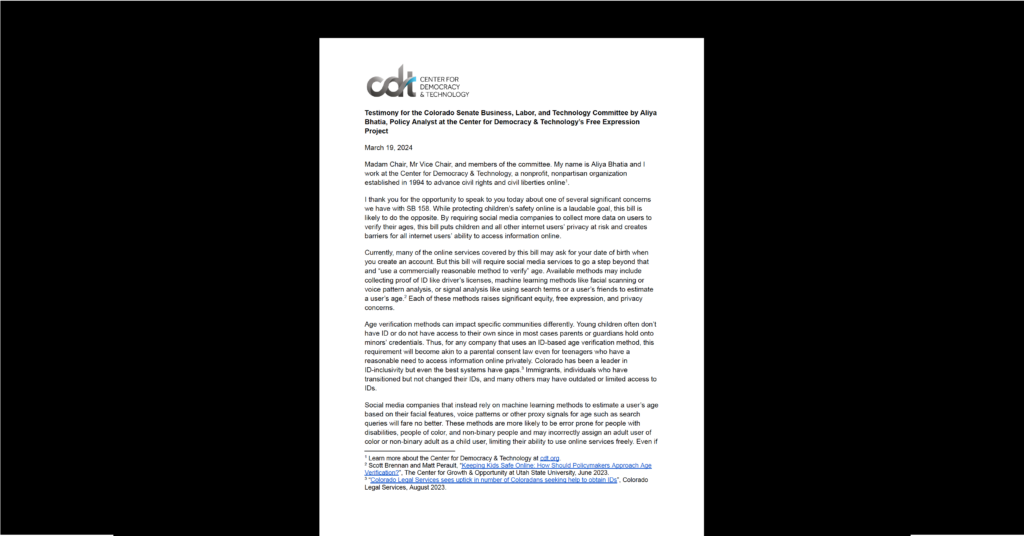Assessing AT&T’s Limits on FaceTime
AT&T took a step in the right direction last week in the simmering dispute over its treatment of FaceTime, the iPhone’s video calling application. But it stopped short, at least for now, of fully addressing the concerns that have been raised by its decision to pick and choose which subscribers will be allowed to use FaceTime on AT&T’s cellular network.
Here’s where things stand. Previously, FaceTime operated only over WiFi connections. Apple’s new operating system, iOS 6, gives FaceTime the ability to operate over cellular networks as well. But in advance of the September launch of iOS 6 and the new iPhone, AT&T indicated that it would not allow subscribers to use FaceTime over AT&T’s cellular network unless they signed up for one of the carrier’s “Mobile Share” data plans. Free Press, Public Knowledge, and the Open Technology Institute argued that this violated the Federal Communications Commission’s Open Internet (a.k.a. Internet neutrality) rules and threatened to file a formal complaint. Then, on Thursday, AT&T announced that over the next several months it will extend FaceTime-over-cellular capability to subscribers of all of its tiered data plans using LTE devices. Presumably, that means many more subscribers get access – though subscribers with legacy unlimited data plans or previous iPhone models are still out of luck. At least for now, that is: AT&T hinted that the remaining FaceTime limitations may be lifted “in the near future.”
In its announcement last week, AT&T reiterated concerns about the adverse impact that widespread usage of FaceTime over cellular could have on network performance. That seems like a valid concern. It isn’t hard to imagine that a sudden influx of FaceTime usage in a localized area on the cellular network could jam up the network in ways that could be problematic for AT&T customers, especially given the limited upstream capacity of AT&T’s network and the two-way nature of FaceTime calls. Indeed, the new iPhone sports a high-definition front-facing camera that could significantly increase the bandwidth intensity of FaceTime video calls.
In CDT’s view, however, network congestion concerns don’t automatically justify any and all network management tactics. There are almost always going to be multiple techniques a carrier could use, and application-agnostic techniques should always be preferred. Indeed, the FCC’s Open Internet Order included “use- (or application-) agnostic treatment” among the principles to guide evaluation of network management practices. Singling out FaceTime is certainly not application-agnostic.
Moreover, the policy still puts AT&T in the position of dictating which particular customers are permitted to use a particular application. And that is really the core issue. Innovation thrives online precisely because the Internet offers a smorgasbord of choices and lets users decide what applications to use. The opposite approach – putting carriers in the role of granting or withholding permission on an application-specific basis – threatens innovation by turning ISPs into gatekeepers and kingmakers. Under this model, innovators need to seek carriers’ blessing in order to be successful. It turns the Internet’s “innovation without permission” model on its head.
Nonetheless, it is good to see AT&T working to relax its restrictions on FaceTime use. In particular, limiting FaceTime-over-cellular to subscribers with a specific payment plan created a situation where it was difficult to untangle AT&T’s congestion-related motivations from its commercial ones. Yes, the congestion concern seems real. But AT&T’s original FaceTime restriction also seemed to serve the entirely separate purpose of pushing customers to adopt a particular payment plan. Given these dual motives, it was hard to have confidence that the limitation would be narrowly tailored to true congestion needs. There could easily have been an incentive to maintain the limitation more broadly or for more time than necessary, and to ignore other viable approaches for addressing the congestion issue.
With Thursday’s announcement, AT&T’s FaceTime restriction will no longer push customers towards a specific data plan. It may, of course, tend to push customers away from legacy unlimited plans and towards LTE devices instead of older ones. Arguably, though, these limitations have more connection, at a broad brush, to the congestion concern. Subscribers on unlimited data plans may lack incentives to avoid excessive usage, and prior-generation cellular networks may lack capacity. (On the other hand, subscribers on tiered data plans can create congestion problems too, especially if multiple users on shared plans consume their data simultaneously in the same local area. And nothing prevents LTE devices from causing congestion on prior-generation networks, since LTE devices use the 3G network when the LTE network isn’t available.) In short, AT&T’s new approach seems more consistent with the explanation that congestion is the dominant driver of the carrier’s actions, but does not completely erase concerns about mixed motives.
Protecting the Internet’s “innovation without permission” environment is a key goal of the FCC’s Open Internet rules. To the extent that those rules or the risk of a complaint helped prompt AT&T to re-think its approach, that goal is being served. Until AT&T fully lifts its FaceTime-specific restrictions, however, concerns will remain about the carrier interfering with decisions that belong in the hands of application developers and end users. To preserve and promote Internet openness and innovation, carriers should seek application-agnostic approaches to managing network traffic and congestion.


